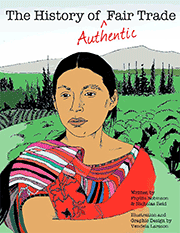
The view from La Ilusion
There’s a buzz of activity in the CIRSA office as producers come in from their communities to get their initial payment (called an advance) for the first beans of the harvest that they’ve turned in to the co-op. At CIRSA, the volunteer board carries out most of the responsibilities, so a lot of on-the-job training is happening during this first month: the newly-elected board shadows the former members who stick around to ensure a smooth transition in operations. Jose Castillo Lopez, the treasurer, is learning how to fill out receipts and keep accounting ledgers; the president, Juan Carolos Perez Perez, is sitting at a computer, learning his way around the keyboard. School was not an option for these guys, whose ages range from 30s to 50s, and so most have no more than a second or third grade education. The entire endeavor is both ambitious and highly impressive.

Andres Diaz Diaz and Victor Hugo Garcia Lopez

Don Andres Diaz Diaz
The first (and sometimes only) language many CIRSA producers speak is either Tzoztil or Tzeltal. So a good part of our conversations occur in this hilarious mix of four languages as everyone good-naturedly tries to learn a few words of someone else’s primary language: the resulting conversations are absurdly funny. In Tzotzil, new is “mol” (I have no idea how it is really spelled) and old is “hache”. So each time someone introduces himself as treasurer or vice president, the others say to me, he’s the treasurer “mol” or he is the treasurer “hache”. Then someone speaks and they look at me, point at him, and wait for me to respond, testing my memory. “ Isidro…mol”, I say and they break into peals of laughter.
Filiberto has a few jokes he’s clearly been waiting for the right moment to share. “Did you know that even dogs in Chiapas speak Tzotzil? Waf waf,” he says and points to a plate of tortillas. “The frogs too: lek, lek. Good.” Although they’ve all undoubtedly heard these jokes before, everyone, including me, chuckles each time he repeats them. I’m sure it’s his delivery. “Lek oy,” says Juan Carlos, smiling. “This is good.”
Despite the brevity of my time here, the visit takes on a certain rhythm. Breakfast with Filiberto and the board members. (Today’s is a mouth-watering meal of memelas de calabasa (something like a pumpkin crepes) with beans.) 

 Then several hours up on the rooftop for long conversations about CIRSA and Equal Exchange, a delicious hot mid-day meal, followed by visits to the communities and coffee farms, and then a few hours in the evening socializing with whichever board members are up for it.
Then several hours up on the rooftop for long conversations about CIRSA and Equal Exchange, a delicious hot mid-day meal, followed by visits to the communities and coffee farms, and then a few hours in the evening socializing with whichever board members are up for it.
On the first full day of my visit, I spend a very somber morning with Don Andres and Don Bartolo. I’m filled with deep respect as they tell me stories of hardship and suffering at the hands of the plantation owners, countless marches to government land reform offices in San Cristobal and Tuxtla Guttierez to fight for basic rights most of us take for granted, then periods of more violent confrontations as the landowners fight back. Don Andres’s eyes tear up when he speaks about his months spent in prison for his organizing efforts. My heart is heavy with what he’s had to endure and also filled with appreciation that he is willing to share these difficult memories with me. I can’t do the story justice here, but I have all our conversations recorded and I have promised to write down what I can and share it more fully in the not too distant future.
Filiberto comes to see how we’re doing. A few of the newer (and younger) board members have been listening to the stories as well, and those that were attending to the farmers have now also joined us. The air is very heavy as the weight of their stories settle in the air. I’m feeling a little badly as it was my questions that brought on this dark mood.
It’s time to return to the present and I decide this is a perfect moment to share greetings from the Equal Exchange staff. Customer service representatives have made a card to send their salutations and appreciations to CIRSA. Sales representatives have sent “We Own It” co-op buttons with the two pines international symbol of co-ops. They love them. Even better, we have made buttons to promote our Authentic Fair Trade Campaign, that say “I stand with small farmers” and I have brought dozens to share with them. This allows us to talk about the campaign and our support for small farmer co-ops. We talk about the Small Producer Symbol and they let me know that they will be registering. I read them handfuls of greetings that individual Equal Exchange worker owners have sent, accompanied by photos. This enables us to have lengthy conversations about Equal Exchange, how we work, and what motivates us to do our jobs.

The greetings cheer folks up and then I take out samples of some of the newest products Equal Exchange has begun selling since my last visit to CIRSA. They’re fascinated with the Tamari Roasted Almonds, intrigued with the new peanut butter chocolate candy bars, and completely into the new fruit and nut chocolate bars. They ask me dozens of questions about how the almonds are processed, how much they sell for, where the chocolate bars are made, where the cacao comes from, who does the packaging? They love the package design (although they have suggestions for how to make them easier to unwrap).
We break for lunch and then pile into the truck for afternoon farm visits. One day we travel to the community, La Ilusion where a meeting has been arranged with twelve producers who are members of CIRSA. After a brief discussion about how they’re doing and concerns about coffee prices and coyotes (intermediaries), we visit a few of their well-shaded farms. The coffee trees are filled with beans, just starting to ripen. The plots here are tiny, micro-farms really, but at least the soil is very productive and their yields are higher than average. All in all, they are expecting a good harvest this year and their biggest concern is whether CIRSA will be able to match the prices currently being offered by the coyotes. 

On the second afternoon, we visit Victor Hugo’s farm, “paradise” as he’s been referring to it all week. We tour the coffee farms and then meet his family and have some refreshments.












At night Filiberto, Rosenda, Ambar, Manuel, and Victor Hugo come by my hotel around 9 pm. It’s time to have a cappuccino at the café CIRSA has recently opened right in the town square. CIRSA sells a small portion of their coffee into the national market and the café is a popular night spot for the residents of Simojovel.

Juan Carlos and Manuel in CIRSA’s new cafe
We sip our coffee and continue talking, mostly now about the elections. The town hall is to our right, facing the park, and there is a line of police, backs against the wall, with their rifles ready. The PRI party has won the elections in Simojovel, as in most of Chiapas and the country. But accusations of fraud are rampant, the roads into town were blockaded for days in protest, and now the town’s angry residents are refusing to let anyone enter the municipal offices and begin assuming their posts.
Despite the graffiti covering the wall declaring the new mayor a puppet and demanding justice, the row of heavily armed police facing the town square, no one seems particularly worried. Trash is piling up on the streets since the new town council can’t begin carrying out municipal services. Still, someone has set up a projector and is showing a movie on the white wall of the town hall. Rows of kids sit in the square watching the entertainment oblivious, or ignoring, the drama unfolding around them.
On my last day at CIRSA, Filiberto uses the occasion of my visit, not just to update me on how CIRSA has been doing in the past few years, but to also inform and educate the new board members. He shows us an impressive power point presentation that he’s put together keeping in mind the low levels of formal schooling held by most board members. Filled with pie charts and easy to grasp charts, we get a new sense of CIRSA’s current situation. Finally, having covered CIRSA’s past and present, he asks each member of the Board to share with me their vision of the future. What would they like to see? If they are successful, what will CIRSA look like in a few years?
CIRSA’s former president, Don Isidro sums it up: “This organization has done so much for us. As producers, we have all been helped greatly by being part of this organization. I have been part of CIRSA for 20 years now and today we are all so much more conscious of our situation, what we face, and how to overcome our challenges. We want to continue raising awareness amongst our members about the importance of staying organized. Everything we have achieved is because of this organization and we don’t want the younger members to forget that. We want to increase our coffee production and get higher prices for it. We want to attract more members and to diversify our products.”

Don Isidro and Don Manuel
In the morning, I catch a ride to Tuxtla Guttierez with Filiberto and the new and old Presidents (that’s right, the mol and the hache): they have an appointment at a local bank to discuss their line of credit. I say my goodbyes to the remaining board members and promise to return in January when the coffee is in full harvest. This time, I’ll bring a whole group of Equal Exchange worker-owners with me and we’ll spend the nights in the farmers’ homes.

The goodbye photos!

Kolobalik. Thanks everyone.
Read Full Post »






















































